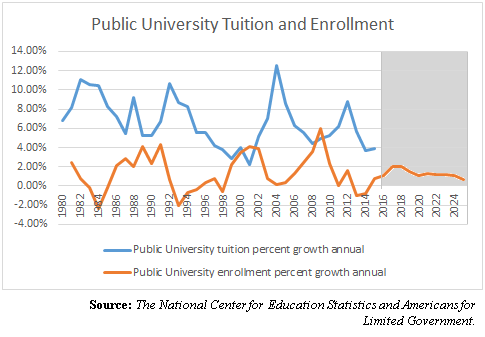By Natalia Castro
Hillary Clinton lost the youth vote to Bernie Sanders, now to compensate, she’s trying to be him to get it back. Clinton has agreed to meet Sanders halfway on education policy in an attempt to convince America’s college age youth that she is their advocate.
The only problem is that her plan turns out to be just another ineffective and costly political tool — by promising to pay for almost everybody’s college tuition. A plan that could cost more than $1 trillion every decade once fully implemented.
Clinton’s newly unveiled plan states that “by 2021, families with income up to $125,000 will pay no tuition at in-state four-year public colleges and universities — covering more than 80 percent of all families. And from the start of the plan, every student from a family making $85,000 a year or less will be able to go to an in-state four-year public college or university without paying tuition. Students at community college will also pay no tuition.”
The plan also includes restoring year-round Pell Grant funding and promises and immediate executive action to offer a three-month moratorium on student’s loan payments to give students an opportunity to receive additional options.
With no specifics Clinton writes that this will be “fully paid for by limiting certain tax expenditures for high-income taxpayers.”
In 2015, the average yearly tuition price was $6,371 and the year’s public university enrollment was reported as 13,353,000 students, according to data compiled by the National Center for Education Statistics. This data provides a clear picture of tuition and enrollment trends, and allows us to determine how much Clinton’s plan will cost today and in the future.
Clinton’s plan aims to include 80 percent of all public university students, meaning that in 2015 for the 10,682,400 students affected the plan would cost $68 billion at present costs if implemented fully right away. And that’s just for starters.
Tuition has an average annual growth rate of 6.61 percent, and Clinton provides no plan for lowering the actual cost of tuition. Similarly, public university enrollment has grown over time as well, with an average annual growth rate of 1.34 percent.
By 2025 Clintons plan will be fully implemented, if tuition continues growing like clockwork at 6.61 percent a year it will have reached an annual average of $12,304 and enrollment is projected by the Department of Education to be about 15,255,000 students. In order to pay for the education of this class it will costs over $150 billion that year alone.
If the plan went into effect today rather than her 2021 rollout date, given these assumptions, Clinton’s plan will easily add up to $1.1 trillion over 10 years.
No wonder Clinton has neglected to discuss the cost. It would show how her plan to win over the Bernie-loving millennials is nothing but outrageously expensive and inefficient.
Sanders plan was projected to cost $70 billion a year with a third of the costs being burdened to states to pay, Clinton instead chose to place nearly the same costs on the high income tax payers who are also paying for their children’s education.
However, the cost of Clinton’s plan may not stop there.
In order to find the full cost for the Clinton plan, we must acknowledge two key limitations.
First, the Clinton plan is only assisting students in paying for public universities which is why we are using enrollment statistics for public universities. However, these enrollment numbers do not account for the inevitable effect of students who might have otherwise attended private schools, but that now have a greater incentive to attend public universities. Meaning enrollment numbers, and thus costs, could be higher. Second, with an influx of students entering the public university system, schools will have to accommodate to the need for larger classrooms, more buildings, more staff, and other expenses, driving tuition costs even higher. The cost of these consequences to the Clinton plan are hard to quantify may nonetheless be detrimental.
But even assuming public university tuition cost and enrollment follow their average growth trends over the next 10 years, the plan will still cost more than trillion dollars its first ten years.
This is not a plan to improve higher education and it does not aim to mitigate costs into the future. It is a blanket promise that Clinton is attempting in a desperate bid to gain the trust of millennials and appeal to the Sanders fans who have vowed to never vote for her. Clinton’s college plan is not an altruistic attempt to provide higher education, but a $1.1 trillion cynical, political ploy.
Natalia Castro is a contributing editor at Americans for Limited Government.









